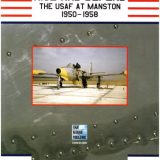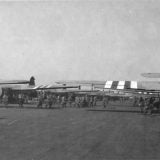A New Year’s Day present to the Germans of a Handley Page O/100 – 1st January 1917

Handley Page O/100 1463 that left Manston for France but was captured by the Germans, piloted by Flt Lt Henry Connell Vereker on 1st January 1917. The aircraft was later repainted as shown in this photo. This was the aircraft suggested might have paid a return visit on this day and shown here with other captured aircraft. The photo is thought to have been taken some time later as the SE5a in the foreground is thought to have been B507 of 60 Squadron, which was captured in early October 1917, however sources suggest it crashed at Johannisthal aerodrome on 22 August 1917. Beyond the Handley Page are a Camel, RE8 and DH4 amongst others.
Handley Page O/100 1463 “L’Amazone” flown by Flt Lt Henry Connell Vereker, accompanied by Handley Page O/100 1462 of Sub Lt Sands left from Manston just before noon for Villacoublay in France on a foggy, wintery day, leaving within 15 minutes of each other for deployment to RNAS 3 Wing at Luxeuil-les-Bain under the command of Squadron-Commander John Babington.
Two attempts had been made to fly the Handley Pages to France in December, but each had been turned back by engine problems. Sub Lt Sands in 1462 reached Villacoublay by dead reckoning, but Lieutenant Vereker in 1463, with Lieutenant Hibbard with the rest of the crew, observer Lt. Sidney Reynolds HIBBARD, Leading Mechanics Duncan KENNEDY F.1866 RNAS, Francis Arthur WRIGHT F.9197 RNAS and Air Mechanic First Class Walter William HIGBY F.8940 RNAS (sometimes reported as Harold Vienna) went astray because of a compass error and on descending to an altimeter reading of 200 ft could find no break in the cloud, so they climbed back to 6,000 ft where they spent some time trying to fix their position. With fuel running low, they had to come down again and were able to land in clear air after sighting a church spire at an altimeter reading of 500 ft. They left their aircraft to enquire their position, but found too late that they were behind the German lines at Chalandry, near Laon; they hurried back to make an immediate take-off, but were met by an infantry patrol; in fact Vereker had already climbed up the entrance ladder, but was hauled down by the seat of his breeches, so he had no chance to set fire to the machine.
The amazed members of the German unit found themselves in possession of not only a new bomber type but also comprehensive performance documentation.
It is recorded by some that they landed at an enemy airfield, Flieger Abteilung (A) 208 at Chalandry near Laon, some 12 miles inside German-held territory. Vereker refused to fly 1463 again, so it was dismantled for transport to Johannisthal, where it was re-erected after detailed examination. Marked with the German Eisenkreuz, it was paraded with other captured Allied aeroplanes and is reputed to have been flown to 10,000 ft by Manfred von Richthofen at Essen in a demonstration before Kaiser Wilhelm II.
The aircraft was painted and flown in German markings until it later crashed at Johannisthal aerodrome on 22 August 1917 (some suggest 22nd April 1917) after its aileron cables had been inadvertently crossed during maintenance work.
Vereker was “Mentioned in Reports” for valuable service while in captivity and repatriated on 3rd January 1919, although as Captain, Vereker was transferred to the Unemployed List on 14th July 1919.
‘For gallantry whilst Prisoners of War in escaping, or attempting to escape, from captivity, or for valuable services rendered in the prison camps of the enemy.’ M.I.D. London Gazette 16 December 1919
On 30th August 1939 he was granted a commission in Class CC of the RAF as F/Lt (Honourary S/Ldr) in the Administrative and Special Duties Branch. He re-engaged as Flight Lieutenant in the Royal Air Force Volunteer Reserve in May 1940. and rose to W/Co (Temp) on 1st July 1943. He eventually relinquished his commission on 10th February 1954 retaining the rank of W/Co after a remarkable period of service. He died in Abingdon, Berkshire in 1993.

Captain H. C. Vereker’s British War and Victory Medals, with M.I.D. oak leaves
Vereker’s British War and Victory Medals, with M.I.D. oak leaves were auctioned on 15th September 2021 for £80 by Noonans, Mayfair but when put up for auction again on September 11th 2024 it appears they were unsold..
Cpl Mech Wright and Hibbard were repatriated on 13th December 1918. Hibbard was transferred to the unemployed list in February 1919.
Cpl Mech Kennedy was repatriated on 26th December 1918
Air Mechanic First Class Higby was repatriated on an unknown date.
Hibbard’s sketchbook of 34 pages which he made whilst a POW at a camp at Hanoverisch Munden was auctioned on 23rd April 2020 by Forum Auctions for £170.

One of Lt Sidney Reynolds Hibbard sketches from his sketchbook kept by Hibbard as a POW at a camp at Hanoverisch Munden during 1917

Handley Page O/100 1463 “L’Amazone” shortly after its capture

Handley Page O/100 1463 “L’Amazone” shortly after its capture
Published with permission from ‘Bloody Paralyser – The Giant Handley Page Bombers of the First World War’ by Rob Langham (Fonthill Media, 2016):
Before the operational career of the Handley Page bombers had even started, the Germans were to know all they needed to know about the design itself. When HPs 1462 and 1463 attempted to fly from Manston to Villacoublay on the first day of 1917, despite HP 1462 making the journey with no problems, HP 1463 landed 12 miles behind German lines, delivering a fully intact brand-new Handley Page O/100 complete with two officers and three air mechanics to a German airfield at Chalandry. One version of events is that the pilot, Flight Sub-Lieutenant Henry Connell Vereker, ran back to the aircraft in an attempt to take off, but as his head and shoulders were just inside the fuselage he was pulled down again by a German. The men were interrogated and then spent the rest of the war as prisoners.
As well as the aircraft itself, there were technical reports and other paperwork that proved interesting to the Germans, and, after being dismantled and transported to Germany, 1463 was reassembled and flown by the Imperial Air Service, complete with insignia. It was written off in a crash on 22 August that year, apparently due to the cabling for the ailerons being reassembled incorrectly.
There were claims later that the Handley Page design was used as a basis for the Gotha G.IV and G.V bombers, a myth that still exists today. Apart from a very basic likeness in design, i.e. both being large, twin-engine biplane bombers, there were no real similarities in the two designs
First published: 1st January 2017


















